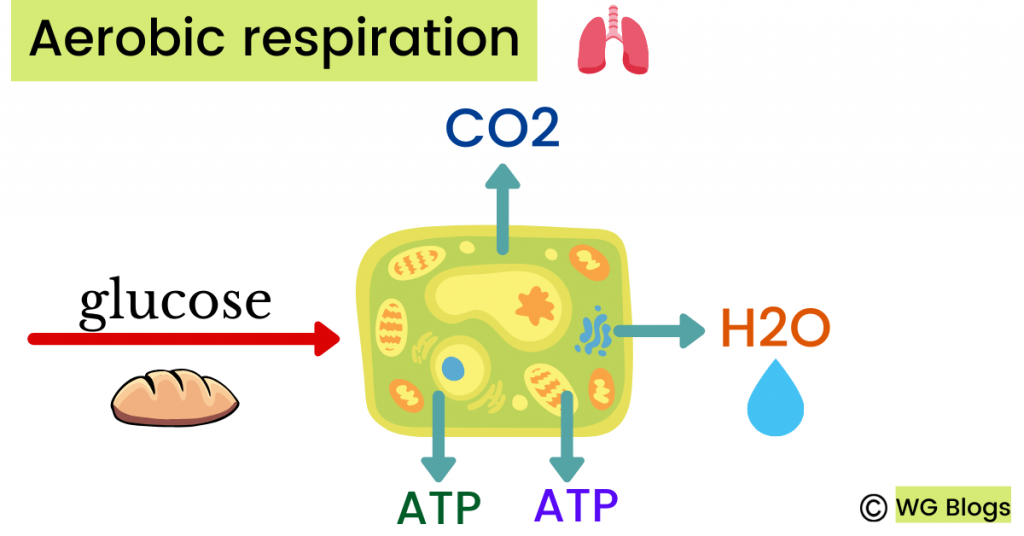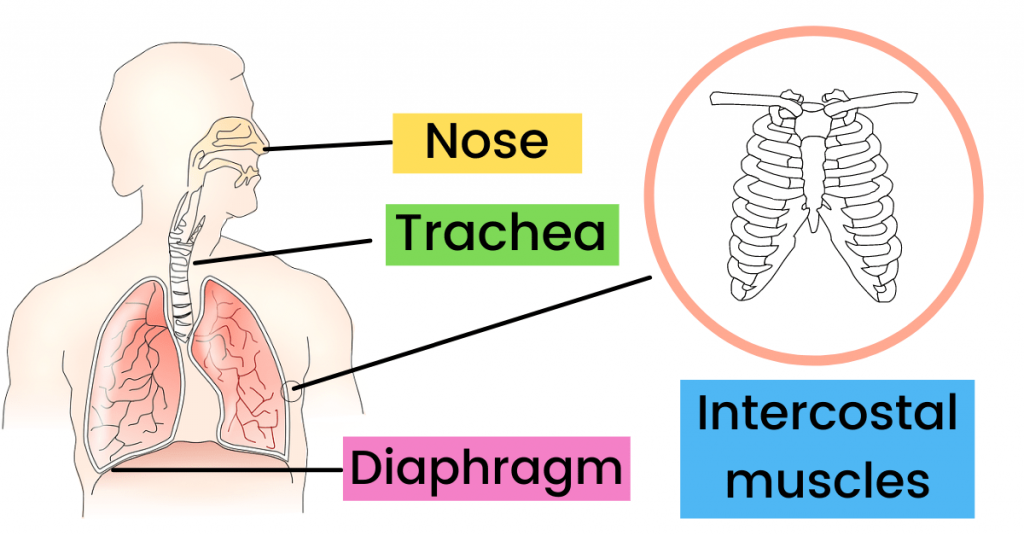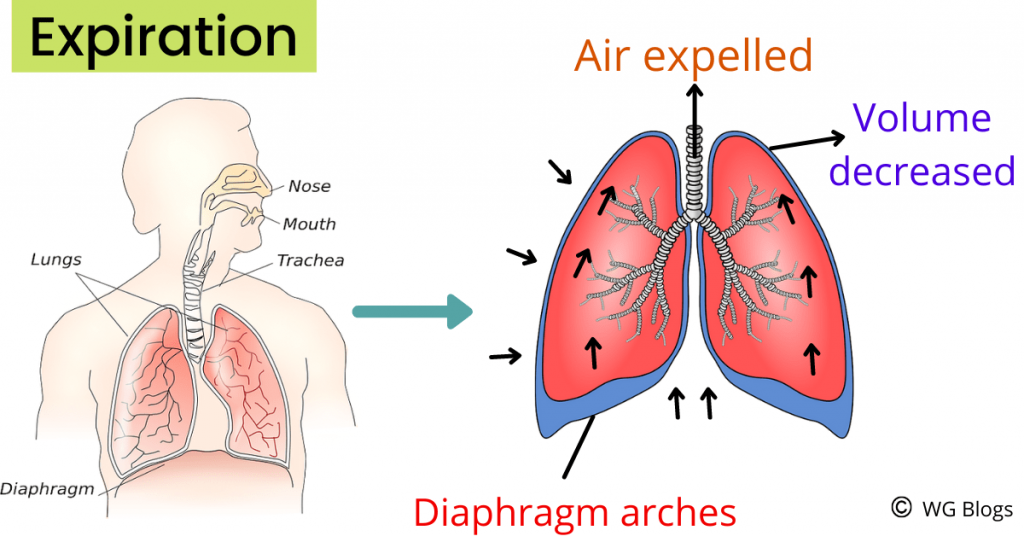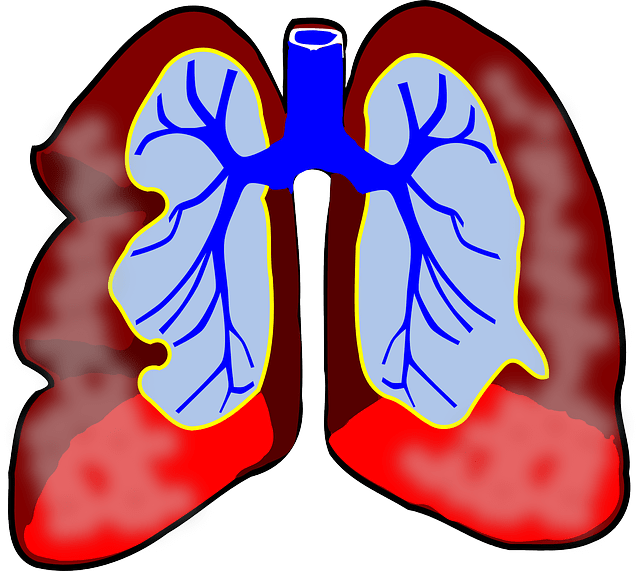Respiration is a process that releases energy from glucose so that our life processes can carry out.
Our respiratory system is adapted for gas exchange. Therefore, it is also defined as a process in which oxygen moves into cells and tissues and carbon dioxide is removed.
Ventilation (in and out the movement of air from the lungs) and perfusion (circulation of blood in capillaries) allow gas exchange to take place.
It was essential to mention these terms because some students confuse respiration with ventilation. However, these two terms are entirely different.
This was all about the introduction of this topic. Now, let’s discuss some significant details and concepts for this topic in detail now.
Types of respiration:
Aerobic respiration:
You need to know that respiration is essential for multiple processes such as growth, development, repair, movement and control of the body temperature.

These processes require energy that is released from glucose so that the chemical reactions can occur.
In aerobic respiration, oxygen is present to release energy from glucose. In other words, glucose and oxygen react (in cells) to produce water, carbon dioxide and energy.
You can use the following equation to remember this reaction:
glucose (C6H1206) + oxygen (O2) → carbon dioxide (CO2) + water (H20) + energy (ATP)
The glucose molecules split apart using oxygen to produce energy and the by-products (end-products) of this reaction are carbon dioxide and water.
This process takes place in multicellular organisms (composed of more than one cell) including plants and animals.
Note: In plants, oxygen enters through the stomata (cell structure in the epidermis of tree leaves) to allow photosynthesis to take place. As a result, food is produced and energy is released.
Now, I have a question for you over here. Apart from glucose, do fatty acids and amino acids also produce energy (ATP) during this process?
The answer is yes! The cells utilise oxygen to breakdown amino acids and fatty acids as well as to produce ATP.
Where does respiration take place? This process occurs in the mitochondria (cell organelle that generates energy for cells biochemical reactions) of the cells.
These are some of the very important concepts that you should be familiar with, so do learn them.
Anaerobic respiration:
Ever wondered why your muscles keep working even when you are exercising vigorously and they are very low on oxygen? The answer is anaerobic respiration.
In this process, energy is produced without oxygen so that the body keeps functioning.
In animals, glucose is converted into lactic acid (chemical by-product) while in plants, it is converted to ethanol and carbon dioxide.
You should know that this process produces very less energy (ATP) as compared to aerobic respiration because the glucose molecules are partially broken down.
The end-product, lactic acid, accumulates in the muscles which cause muscular fatigue. Similarly, cramps, muscle pain and tiredness also occur.
Lactic acid is transported to the Liver where it is either oxidised to water and carbon dioxide or to glucose, then glycogen to restore the muscles.
This process requires oxygen and the amount of oxygen required to remove lactic acid is known as oxygen debt.
The microorganisms, such as yeast, respire anaerobically to produce ethanol, carbon dioxide and energy. This is known as fermentation and this type of respiration is referred to as alcoholic fermentation.
You can use the following table to distinguish between the types of respiration.
| Aerobic | Anaerobic |
| 1. Require oxygen | 1. Does not require oxygen |
| 2. Needs glucose | 2. Needs glucose |
| 3. Carbon dioxide and water formed | 3. Lactic acid formed |
Now, you might be wondering, how do we know that the living organisms respire? Let me prove this with the help of an investigation.
Investigation respiration:
We learned that carbon dioxide is an end-product of this process. We can use limewater to test the presence of carbon dioxide.
If it is bubbled through limewater, it turns from clear to milky white in colour (white precipitate is formed).

Firstly, breathe in through the mouthpiece which draws air from the atmosphere to tube A. When you breathe out, the mouthpiece bubbles the exhaled air through tube B.
After a few breathes, the limewater in tube B will turn milky white due to the presence of carbon dioxide.
Further reading:
Transport in Plants Made Simple | GCE O Level Notes
Excretion | GCE O Level Biology
Energy changes | GCE O Level notes
This is a simple investigation that can tell us that carbon dioxide is one of the end-products of this process. Now, it is time for you to investigate whether oxygen is used by the living organisms to respire?
The human gas exchange system:
The human respiratory system contains the organs to provide oxygen and remove carbon dioxide from the body.
These organs are required because the substances cannot enter and exit the body through simple diffusion in multicellular organisms.
Our respiratory system contains two lungs, tubes leading to the lungs (emerging from the mouth and nose) and structures in the chest for the movement of air.
Before learning about the gas exchange system in mammals, you should be familiar with the following terms:
- Inspiration (Inhalation): The taking in of air and water (the action of breathing in).
- Expiration (exhalation): The giving out of air and water vapours (the action of breathing out).
The lungs, trachea, larynx, pharynx, nasal passages and the diaphragm are some essential parts that carry out this process. Do not worry, we will understand these terms in detail.
- The air enters the body (inhalation) through the two external nostrils which have hairs and a moist mucus membrane.
The hairs prevent harmful particles from entering into the body along with the dust particles and the air is moistened before it moves into the lungs.
- Then, the air moves from the pharynx (part of the throat behind the mouth and nasal cavity) to the larynx (voice box) and then to the trachea (the tube that connects the larynx to the bronchi of the lungs).

The bronchi are the airways that lead to the trachea from the lungs and branch off until they reach alveoli (tiny sacs that allow the exchange of gases).
Their epithelial lining contains cilia (a hair-like structure which secretes mucus) and sweeps the dust particles up the bronchi.
- The alveolar walls are moist and thin and they are supplied with blood capillaries because the exchange of gases has to occur.
The alveoli in the lungs increase the surface area which allows the rate of gaseous exchange to increase as well. These are some of the features of alveoli which you should know.
In this way, oxygen moves into the blood and carbon dioxide move out of the blood.
Breathing mechanism:
Intercostal muscles, that run between the ribs, are multiple groups of muscles that help to form and move the chest wall. They are mainly involved in breathing (expand and shrink the chest cavity).
During inhalation (breathing in), the external intercostal muscles contract while the internal intercostal muscles relax. The movement causes the ribs to move upwards.
Note: During breathing in, the pressure inside the chest reduces because the volume of ribcage increases.
Moreover, the diaphragm contracts and flattens to lower the air pressure inside the lungs. This causes the air to move into the lungs from a high-pressure area (atmosphere) to low pressure.
You can use the following technique (RICE) to remember what happens to the muscles during inhalation.
R: relax
I: internal intercostal muscles
C: contract
E: external intercostal muscles
When the air moves in, the gaseous exchange between the blood and the alveolar wall occurs as the dissolved oxygen diffuses into the blood and carbon dioxide diffuses out of the blood.
During expiration (breathing out), the opposite happens. The internal intercostal muscles contract while the external intercostal muscles relax.
Similarly, the diaphragm relaxes and arches upwards and the ribs move downwards and inwards. Due to this, the volume of ribcage reduces and the pressure increases which drives air out of the lungs.

You can use the following technique (ERIC) to remember what happens during exhalation.
E: external intercostal muscles
R: relax
I: internal intercostal muscles
C: contract
This was about the breathing mechanism in mammals and how the gaseous exchange takes place during inhalation and exhalation.
You should take note that there is a pause between inhalation and exhalation, this is the time when the gases exchange between the alveolar wall and the blood.
Composition of inspired and expired air:
The inspired air (air taken in during breathing) and expired air (air exhaled during breathing) differ in their composition.
The expired air contains less oxygen as compared to inspired air. However, it contains more water vapours, carbon dioxide and may contain some bacteria as well.
The table below summarises the information:
| Inspired air | Expired air | |
| Carbon dioxide | 0.04% | 4.0% |
| Oxygen | 21% | 16% |
| Water vapour | Variable | Saturated |
| Nitrogen | 79% | 79% |
| Temperature | Atmospheric | Body |
In respiration notes, you should know that Inhaled air contains more oxygen as it has to be used to release energy from food through respiration.
The exhaled air contains less oxygen because it has been used during respiration and the amount of carbon dioxide is more because it has been produced as a waste product (end-product) of respiration.
You should take note that respiration results in a loss of dry mass (mass of the biological sample after the water has been removed), liberates energy and is a catabolic process (the breakdown of molecules into smaller units).
You should be also familiar with some of the respiratory diseases such as:
- Asthma
It is a condition in which the air passages become narrow, swell and produce extra mucus (a fluid substance produced by lining tissues). Due to this, problems such as breathing difficulty and coughing occurs
- Emphysema
The air sacs (alveoli) in the lungs are damaged which leads to shortness of breath and gradually, their air sacs weaken and rupture.

- Bronchitis
It is an infection of lungs due to which the airways become irritated and inflamed. This disease can lead to wheezing and sore throat and coughing is the main symptom of this disease.
Conclusion:
With this, our topic about respiration notes has come to an end. I hope that all your queries have been addressed and all questions have been answered.
Thank you very much for reading and staying with me till the end. The topics such as types of respiration, the human breathing mechanism and respiratory diseases have been explained.
You need to practise plenty of past paper questions to ace this topic as it is very significant from the paper point of view. Stay tuned for more.
